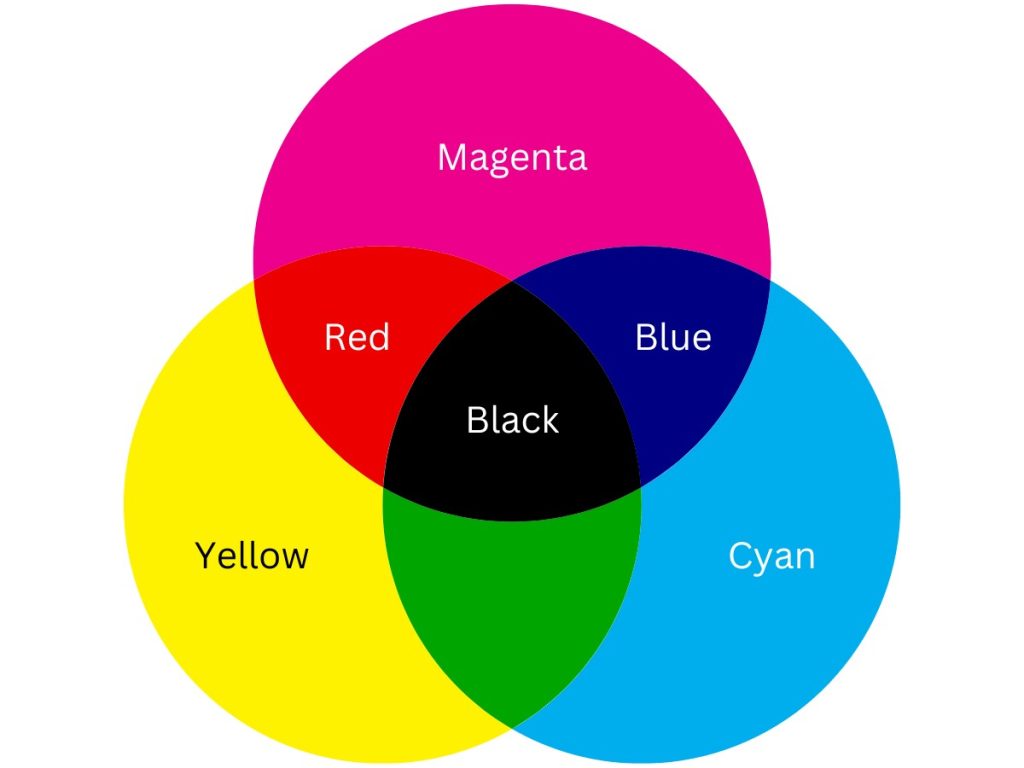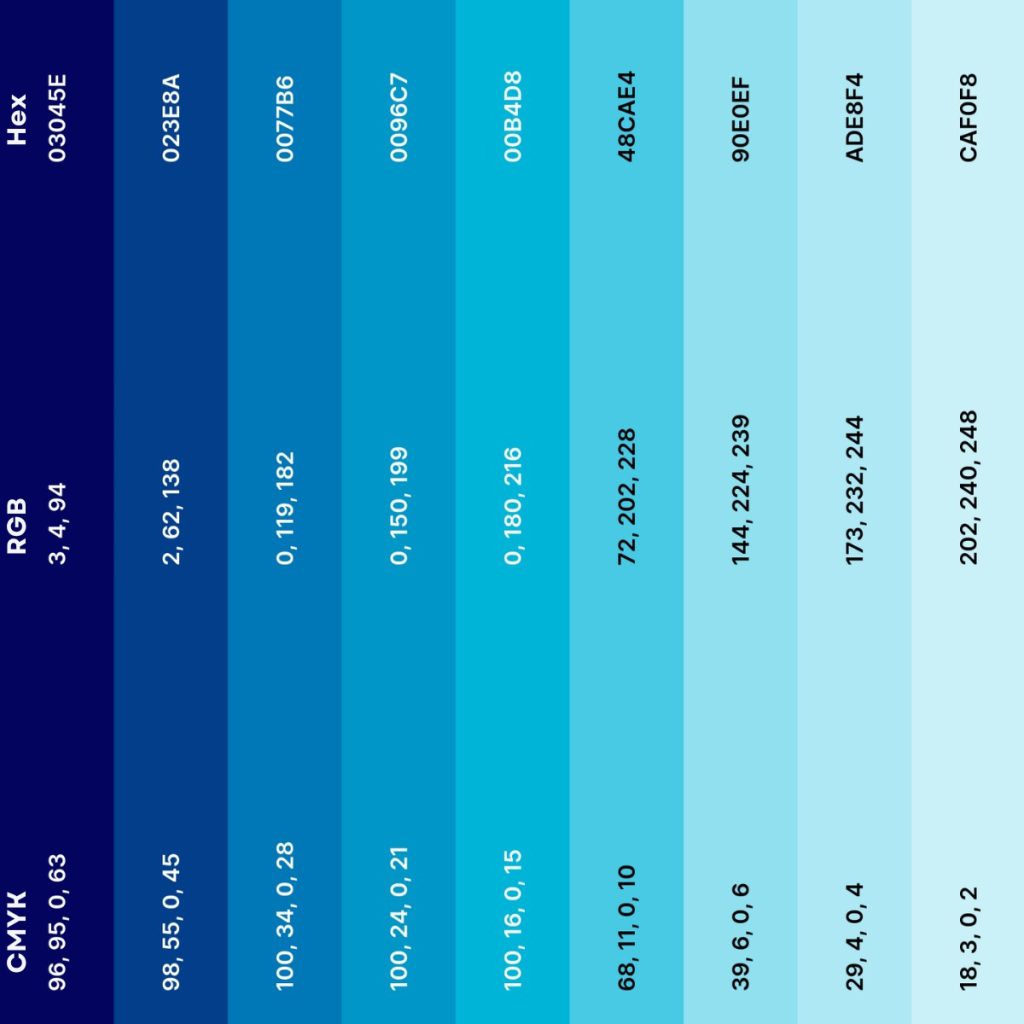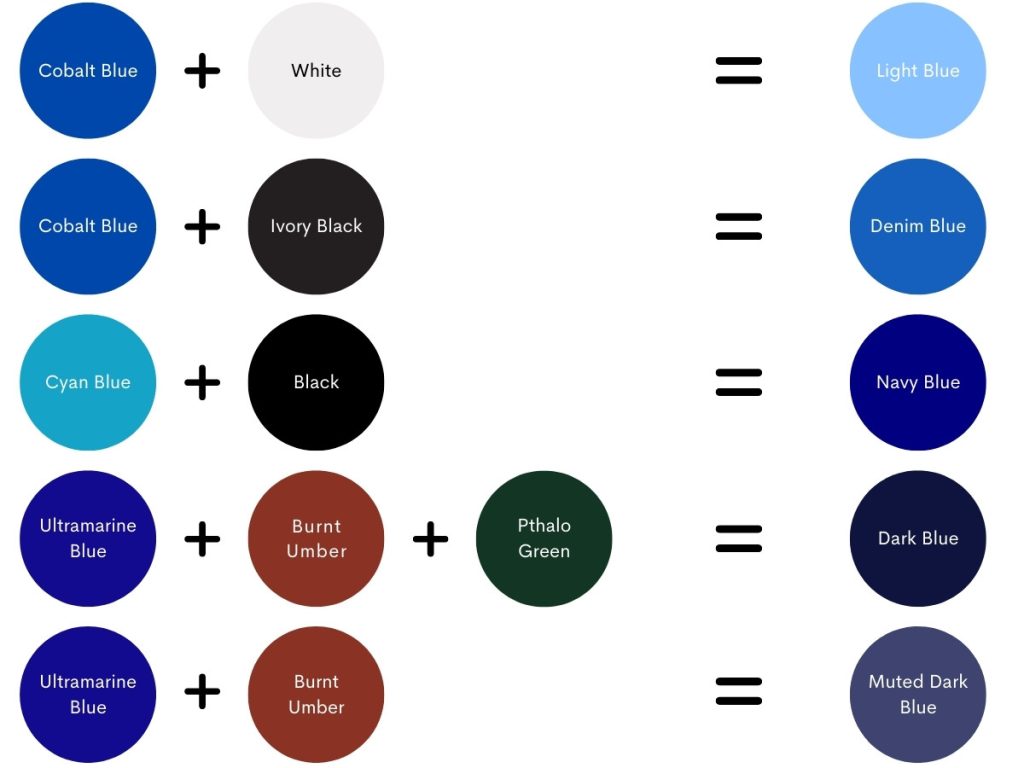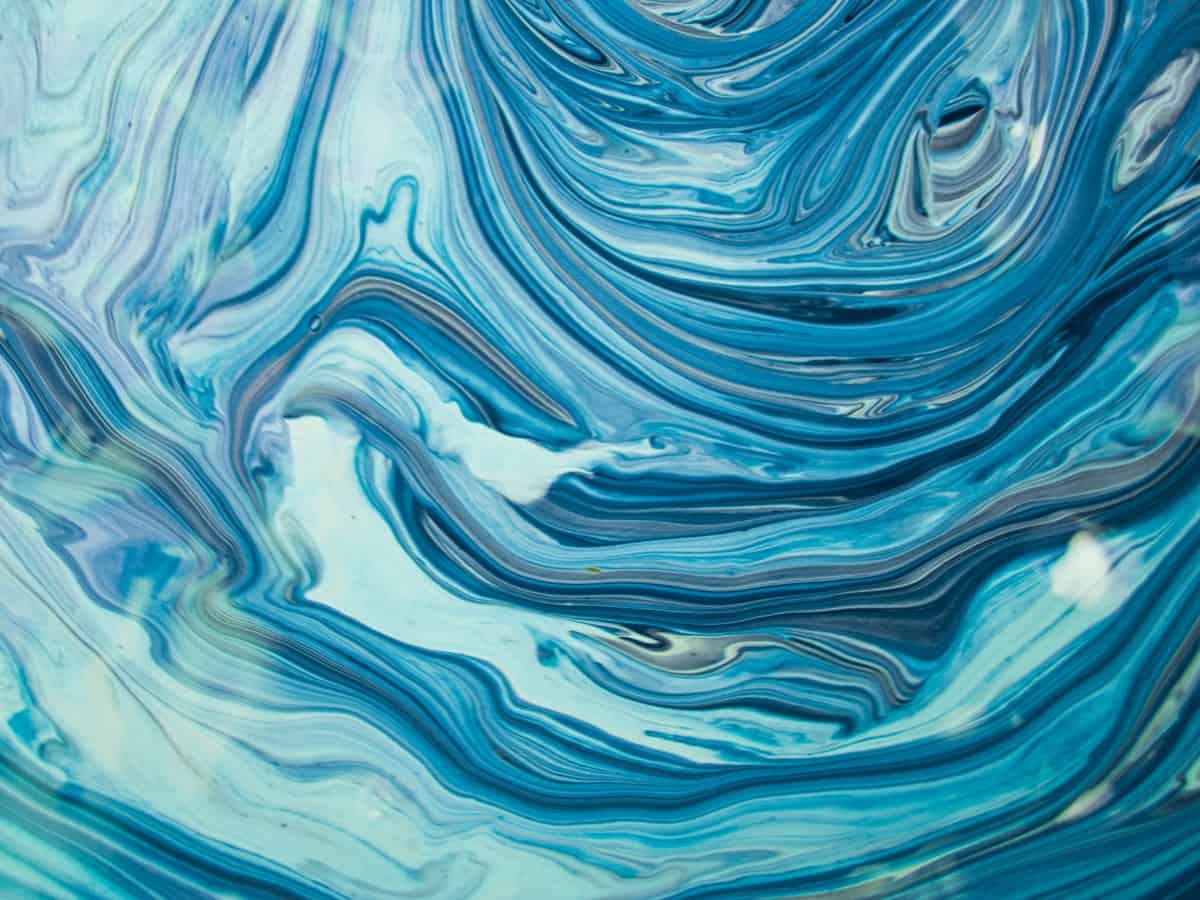Are you wondering what colors make blue or what colors need to be mixed to get blue?
According to some opinions, the short answer to what colors make blue is none because blue is one of the three primary colors in both the RGB color model and the RYB model, which represents the traditional color theory. Thus, you don’t have to mix two other colors to get blue.
If we consider the CMY subtractive color model described below, we will find the answer to the question, “What colors mixed together make blue?”
In order to make blue or get a certain shade of blue, it is necessary to mix two or three colors. Let’s see how we can make different shades of blue by combining others.
What Colors Make Blue?
So, what are the two colors that can be mixed to make blue?
Blue can be made by mixing only two colors: magenta and cyan. We can create a primary color using any combination of cyan, magenta, and yellow according to the CMY subtractive color model.
The color blue can be created by combining magenta and cyan using the CMY model. So we make blue by combining a purplish-red and a greenish-blue.

The CMYK color model is used by printers. This color space uses the same color mixture to create blue: cyan and magenta.
However, as we all know, blue comes in a variety of shades.
How to Mix Different Shades of Blue
Once we have the primary color, we can make any shade of blue we want. In essence, the sky is the limit. So we can make any shade of blue, from light blue (created by adding white to a blue base) to dark blue (created by mixing blue with black).
As a result of the fact that colors can convey emotions and influence our moods, designers and artists create a wide range of colors.
Here are the most popular blue shades and the colors that are used to create them.
| Type of blue | What colors to mix | Percentage of RGB | Hex Code |
| Powder Blue | Royal Blue + White | 69% red, 87.8% green, 90.2% blue | #B0E0E6 |
| Light Blue | Blue + White | 28% red, 35% green, 37% blue | #ADD8E6 |
| Cornflower | Blue + Gray | 60.4% red, 80.8% green, 92.2% blue | #9ACEEB |
| Turquoise | Blue + White + Green | 18.8% red, 83.5% green, 78.4% blue | #30D5C8 |
| Teal | Blue + Green | 0% red, 50.2% green, 50.2% blue | #008080 |
| Royal Blue | Blue + Purple + Black | 25.5% red, 41.2% green, 88.2% blue | #4169E1 |
| Denim Blue | Cobalt Blue + Ivory Black | 7% red, 31% green, 62% blue | #1560BD |
| Cerulean | Ultramarine Blue + White | 0% red, 48.2% green, 65.5% blue | #007BA7 |
| Cobalt | Turquoise + Ultramarine | 0% red, 27.8% green, 67.1% blue | #0047AB |
| Indigo | Blue + Red | 29.41% red, 0% green, 50.98% blue | #4B0082 |
| Dark Blue | Blue + Black | 0% red, 0% green, 45% blue | #00008B |
| Navy Blue | Blue + Black + Orange | 0% red, 0% green, 50.2% blue | #000080 |
After creating the color blue, you can experiment with different shades of blue. Lighter shades of blue can be created by adding white, while darker shades of blue can be created by adding black. Here are some of the most stunning blue hues.

What Colors Make Light Blue?
Light blue is a pale shade of blue, perfect for romantic and dreamy people. Light blue has calming and peaceful connotations.
Light Blue: Blue + White
The easiest way to make light blue paint is by mixing white paint with cobalt blue paint. The more white paint you add, the lighter the blue will be.
Light blue is made up of 28% red, 35% green, and 37% blue, according to the RGB color system.
The CMYK color codes for printers are 25, 6, 0, 10. This means that the CMYK color system uses a high cyan ratio, followed by black and magenta, to print this color. The light blue hexadecimal color code is #ADD8E6.
Cornflower
Cornflower is a medium blue color that has calming properties. It is associated with relaxation and provides a natural cooling effect.
Cornflower: Blue + Gray
The simplest way to make cornflower paint is to combine gray and blue. In RGB, cornflower color is composed of 60.4% red, 80.8% green, and 92.2% blue. In the CMYK color space, the values are 34, 12, 0, and 8.
Glossy Light Blue
Glossy Light Blue is another light blue shade. This shade of light blue is created by combining cobalt blue and white.
Glossy Light Blue: Blue + White
This color is made up of 23% red, 33% green, and 44% blue, according to the RGB color system. Color codes in CMYK are 47, 24, 0, 0. The hex code for light blue glossy is #87C1FF.
Denim Blue
The simplest way to make denim blue paint is to add a small amount of Ivory black to a Cobalt blue base. Begin by adding a little black until you achieve the cobalt blue shade.
Denim Blue: Cobalt Blue + Ivory Black
Denim blue is composed of 7% red, 31% green, and 62% blue in the RGB color system. It has the hexadecimal code #1560BD. The CMYK values are 89, 49, 0, 26.
What Colors Make Cyan?
Cyan is a vibrant greenish-blue color that is associated with serenity, youth, and liveliness. It can also symbolize cleanliness.
Mix green and blue if you want to make cyan paint from two colors. You can add a little more white and yellow to achieve the desired shade of cyan.
Cyan is made up of 0% red, 100% green, and 100% blue, according to the RGB color system. Cyan’s hex code is #00FFFF. It has the CMYK color codes 100, 0, 0, 0.
What Colors Make Turquoise?
Turquoise is a pale blue with green tones. It is associated with calmness, joy, and friendliness, combining blue’s relaxation with green’s growth.
Turquoise can be created by mixing the colors green and blue. You can also add white to achieve a light turquoise color.
To make bluish turquoise, simply add less green than blue to a blue base. If we use more green, the resulting shade will be greenish turquoise.
We mix blue with a little green and very little white to get lighter shades of bluish-turquoise. The more white we use, the lighter the turquoise will become.
Turquoise is composed of 18.8% red, 83.5% green, and 78.4% blue in the RGB color space. This color contains 77% cyan, 16% black, and 6% yellow in the CMYK color space.
As a result, it transmits some of the yellow’s energy. It has the hexadecimal code #30D5C8.
Turquoise is composed of two colors: blue and green.
What Colors Make Dark Blue?
The simplest way to make dark blue paint is to combine black and blue paint. We can begin by applying some black paint. Depending on how much black we add, we get progressively darker shades of blue.
Dark Blue: Blue + Black
Dark blues exude authority and elegance.
Dark blue is composed of 0% red, 0% green, and 54.5% blue in the RGB color system.
Dark blue’s CMYK color codes are 100, 100, 0, 45. This means it employs an equal proportion of cyan and magenta, as well as approximately half black. Dark Blue’s hex code is #00008B.
Royal Blue
The color royal blue is a dark shade of blue, being vibrant and deep blue. It is a lighter shade of blue than navy blue. Royal blue is associated with trust, authority, and confidence.
Royal Blue: Blue + Purple + Black
Because of the proportion of purple in the composition, it also represents royalty. As a result, it is one of the most frequently used colors by the British royal family.
Royal blue can be created by combining equal parts blue and purple. It is also preferable to use only a small amount of black to achieve this shade.
Royal Blue is composed of 25.5% red, 41.2% green, and 88.2% blue in the RGB color space. It is 71% cyan, 53% magenta, and 12% black in the CMYK system. It has the hexadecimal code #4169E1.
Cerulean
Cerulean blue is a deep, opaque, and vibrant blue. It is a blue that falls somewhere between azure, teal, and darker sky blue. Cerulean is associated with the sky, the ocean, and other naturally blue things.
Cerulean: Cobalt + White
The simplest way to make cerulean color is to mix white paint into an Ultramarine blue or Cobalt base.
The best results are obtained by combining phthalic blue and titanium white.
It has the hex code #007BA7 and the RGB values 0, 123, 167, which means it is made up of 0% red, 42% green, and 58% blue. For printing, use the CMYK color codes 100, 26, 0, 35.
Navy Blue
Navy blue is a dark shade of blue that is frequently confused with dark blue and midnight blue. The color gets its name from British naval officers who have worn this color on their uniforms since 1748.
Royal Blue: Blue + Purple + Black
Navy Blue can be created by combining black paint with a blue base. Navy blue is made up of 0% red, 0% green, and 100% blue, according to the RGB color system.
Dark blue’s CMYK color codes are 100, 100, 0, 50. This means it has equal amounts of cyan and magenta and slightly more black than dark blue. Navy Blue has the hex code #000080.
Midnight Blue
Midnight Blue is a royal, timeless shade of dark blue that conveys elegance and refinement.
Midnight Blue: Blue + Black
The simplest way to achieve midnight blue is to combine a small amount of black paint with a small amount of blue paint.
Midnight blue is composed of 15% red, 15% green, and 69% blue in the RGB color space. The CMYK color codes for printing are 78, 78, 0, 56.
Midnight blue has less cyan and magenta and more black in the CYMK system than navy blue and dark blue. Midnight blue’s hex code is #191970.
Tips for Making Shades of Blue
There are numerous ways to create blue shades. However, in order to achieve the desired tone, it is necessary to learn a few basic rules. Some of them are as follows:
- To deepen the blue, use black or grey. Add white to lighten it.
- Add yellow to get a greener shade of blue.
- For a shade of blue closer to purple, add red.
- For a shade closer to light cyan, add green to a blue base.
- For a bold dark blue shade, mix alizarin crimson with pthalo green. Then use it as a base and add ultramarine blue. You’ll get a lovely dark blue color.
- To get a bright dark blue, add dioxazine purple to an ultramarine blue base.

Other factors, such as texture and light absorption, also play an important role. The golden rule that every artist follows to master the creation of color shades is trial and error.
To get the desired shade, start with a blue base and gradually add another color until you achieve the desired result.
What Colors Make Blue Warm?
The simplest way to make blue warm is to add alizarin crimson or burnt sienna to a blue base.
A warm blue color can be created by combining a warm blue base, such as ultramarine blue, with a slightly cooler shade, such as cobalt blue.
The easiest way to create a dark warm blue shade is to mix alizarin crimson into a cobalt blue base.
To make a darker warm blue, combine burnt sienna and ultramarine blue.
What Colors Make Blue and Green?
By mixing the colors blue and green, we obtain Cyan. In the RGB color space, cyan is made up of 0% red, 100% green, and 100% blue.
Turquoise is also created by combining blue and green but in different proportions.
We can also make other colors, such as Cobalt, Teal, or Jade, depending on the proportion of green and blue.
Cobalt blue is created by combining 70% blue and 30% green.
Teal is created by combining 50% blue and 50% green.
Jade is created by combining 70% green and 30% blue.
Getting to the bottom of what colors make blue
So, even though blue is a primary colour, it can be obtained by mixing cyan and magenta, as seen above.
After we’ve obtained the blue color, we can play around with adding white or black to get different shades.
We hope this article has helped you understand what colors make blue and how to mix two or three colors to create different shades of blue.

